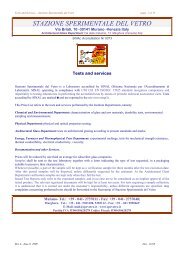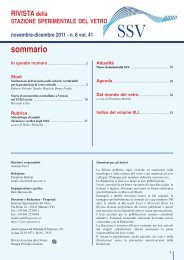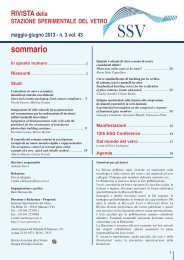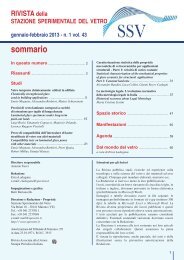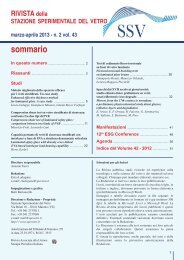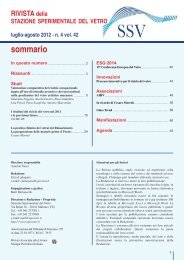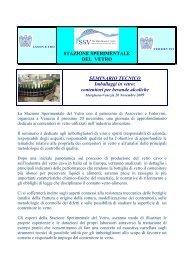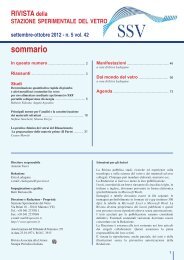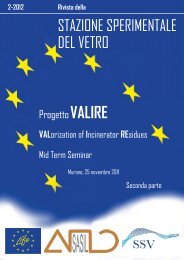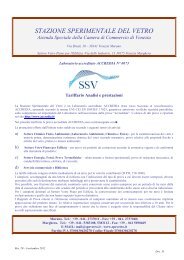RSSV 4 2013.indd - Stazione Sperimentale del Vetro
RSSV 4 2013.indd - Stazione Sperimentale del Vetro
RSSV 4 2013.indd - Stazione Sperimentale del Vetro
You also want an ePaper? Increase the reach of your titles
YUMPU automatically turns print PDFs into web optimized ePapers that Google loves.
4-2013<br />
studies<br />
studi<br />
Rivista <strong>del</strong>la <strong>Stazione</strong> <strong>Sperimentale</strong> <strong>del</strong> <strong>Vetro</strong><br />
Shear resistance and shear modulus of adhesive are<br />
important characteristics and have high influence on<br />
the load carrying capacity and structural behaviour<br />
of the hybrid steel glass beam. The stiffness of the<br />
bonded connection depends on the stiffness of the<br />
adhesive and geometry of the joint. Increasing thickness<br />
of the adhesive will decrease the stiffness of<br />
the joint [1]. Enlargement of the width of joint leads<br />
to an enlargement of stiffness of whole connection,<br />
therefore direct connection on the face of the glasssheets<br />
have a low stiffness because of the small<br />
bonding width. Other geometries of the joint offer<br />
larger bonded surface and therefore higher effective<br />
connection stiffness. Flexible composite hybridbeams<br />
can be pre-designed according to Möhler’s<br />
theory [2] (which is today known as the γ-method).<br />
It can be applied to the hybrid steel glass beam considering<br />
the different material properties of steel and<br />
glass as well as the flexibility of the joint with an effective<br />
moment of inertia with reduced contribution<br />
of the flanges. Therefore it is qualified very well for<br />
the pre-design of hybrid steel glass beams and experimentally<br />
proved on the full-scale test of hybrid<br />
beam with the span of 4m made by CTU Prague [3].<br />
Composite beams with divided glass web<br />
For longer span (more than ca. 6m) there is a need<br />
to divide a web because of fabrication criteria of<br />
the glass. Manufacturing of that beam is more difficult,<br />
but on the other hand, this solution caries the<br />
improvement of the robustness behaviour of whole<br />
structure, because pertinent impact damage can be<br />
isolated on separate part of the web. Static behaviour<br />
of the hybrid beam subjected to bending moment<br />
is completely different in comparison with<br />
previously mentioned hybrid beam with continuous<br />
glass web. Analytical mo<strong>del</strong> is based on the truss<br />
analogy, because behaviour of hybrid beam evokes<br />
truss with some peculiarities due to the elastic shear<br />
connection and the special panel structure of the<br />
web have to be taken into account. The structural<br />
behaviour of the composite beam can be simplified<br />
to the idealised elastic structure, see Fig. 3. According<br />
to this mo<strong>del</strong>, glass panes begin to rotate due to<br />
the increasing load. Shear flow, caused by external<br />
load, produces a moment in each part of the glass<br />
web. It results to a contra moment in the joint between<br />
web and flange. This creates additional shear<br />
stresses in adhesive layer on the edge of the glass<br />
panes and compression at the corners of the pane.<br />
This shear distortion makes rotation of glass panes<br />
and every glass pane of composite beam behaves<br />
like compressed diagonal in truss system. Than internal<br />
forces of this structure can be calculated like<br />
the internal forces of a truss system. This truss analogy<br />
allows an easy determination of the internal<br />
force distribution and reactions between the hybrid<br />
beam components. The total shear flow action in the<br />
adhesive layer can be computed by a vectorial addition<br />
of both orthogonal shear flow values.<br />
Experimental investigations<br />
Described experiments (4 point bending tests) were<br />
aimed to investigate the static behaviour of hybrid<br />
beams with glass web divided to several panes. The<br />
span of test specimens was chosen the same as for<br />
the experiments of beams with the web made of one<br />
glass pane, it was 4m. The same length, detail of the<br />
connection, dimensions of the cross-section as well<br />
as the same type of adhesive allow comparison of<br />
all obtained results. 9 full-scale tests of beams with<br />
divided glass web were performed. Behaviour under<br />
loading was completely different in comparison<br />
with the experiments of beam with glass web from<br />
one panel. Failure of every test specimen started<br />
near the support at the contact of adjoining glass<br />
panes, see Fig. 3 and Fig. 4 for different types of<br />
web-flange connection.<br />
Figure 2. Analytical mo<strong>del</strong> based on the truss analogy<br />
26



